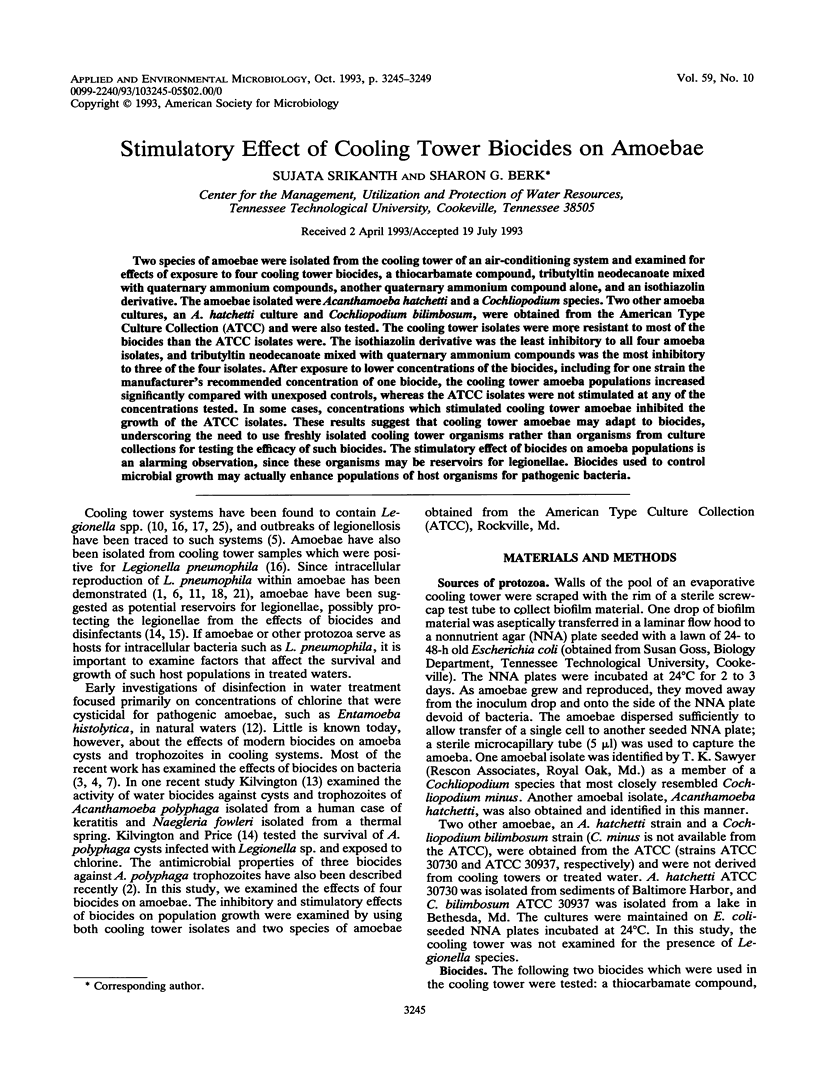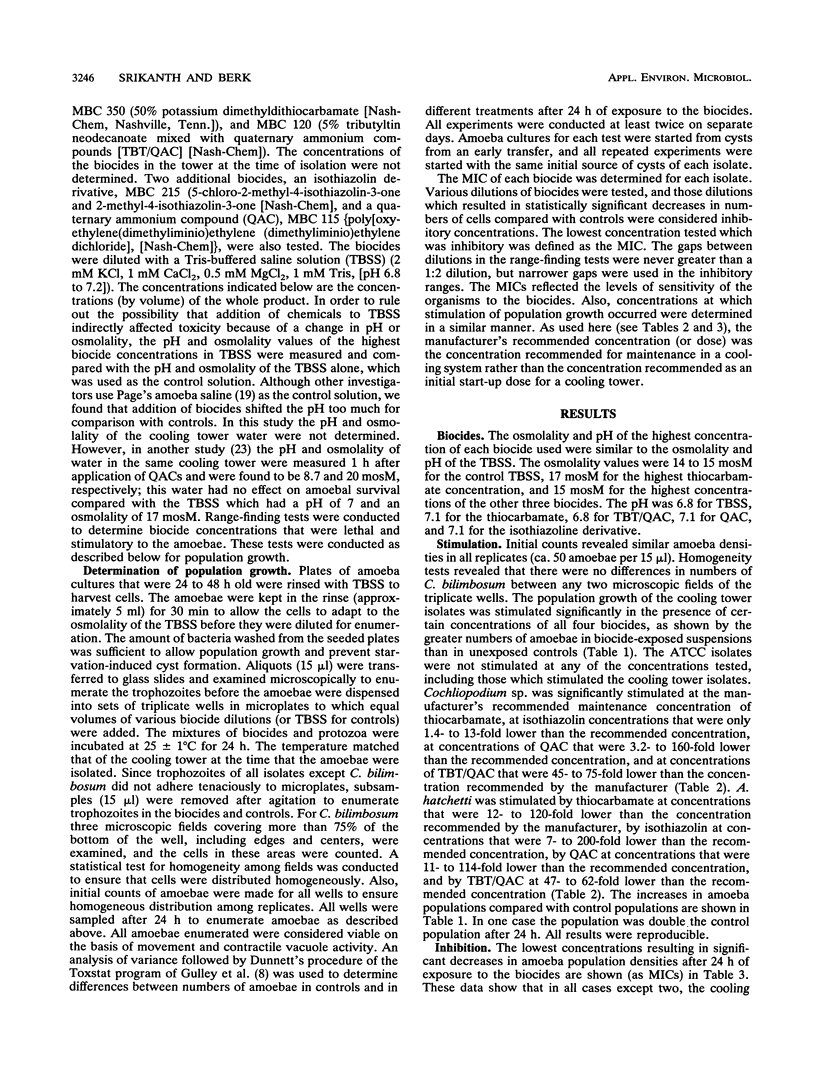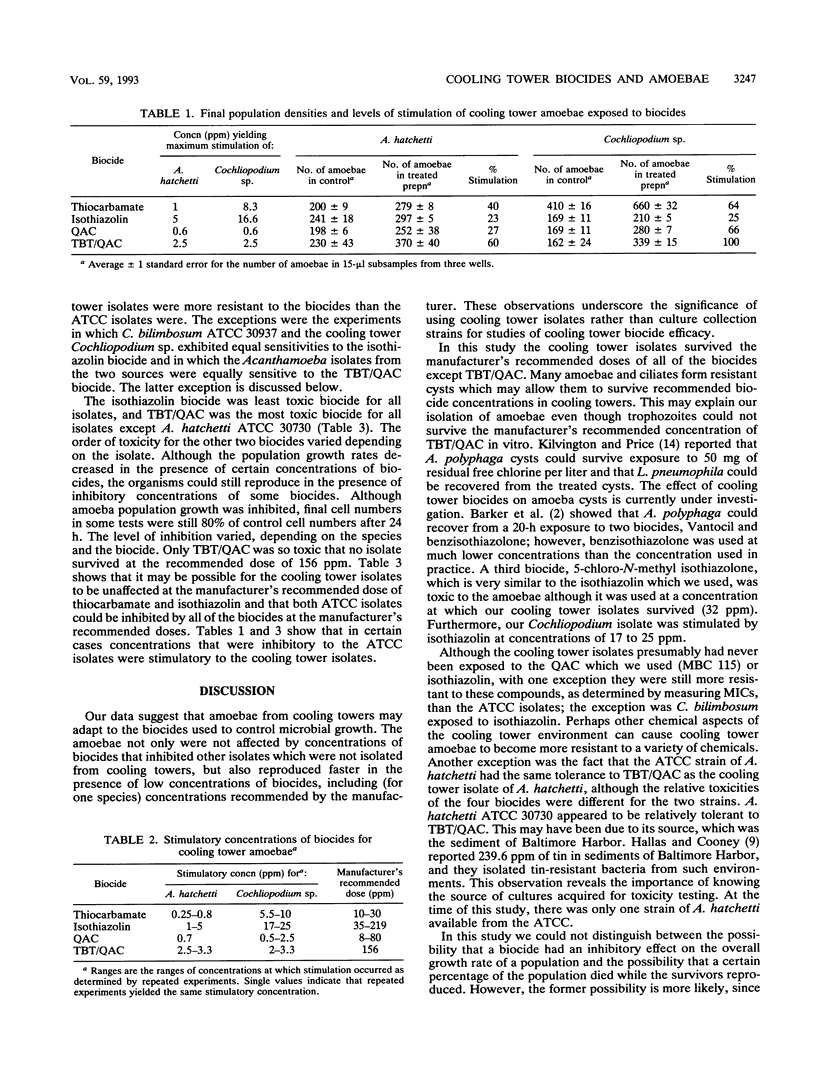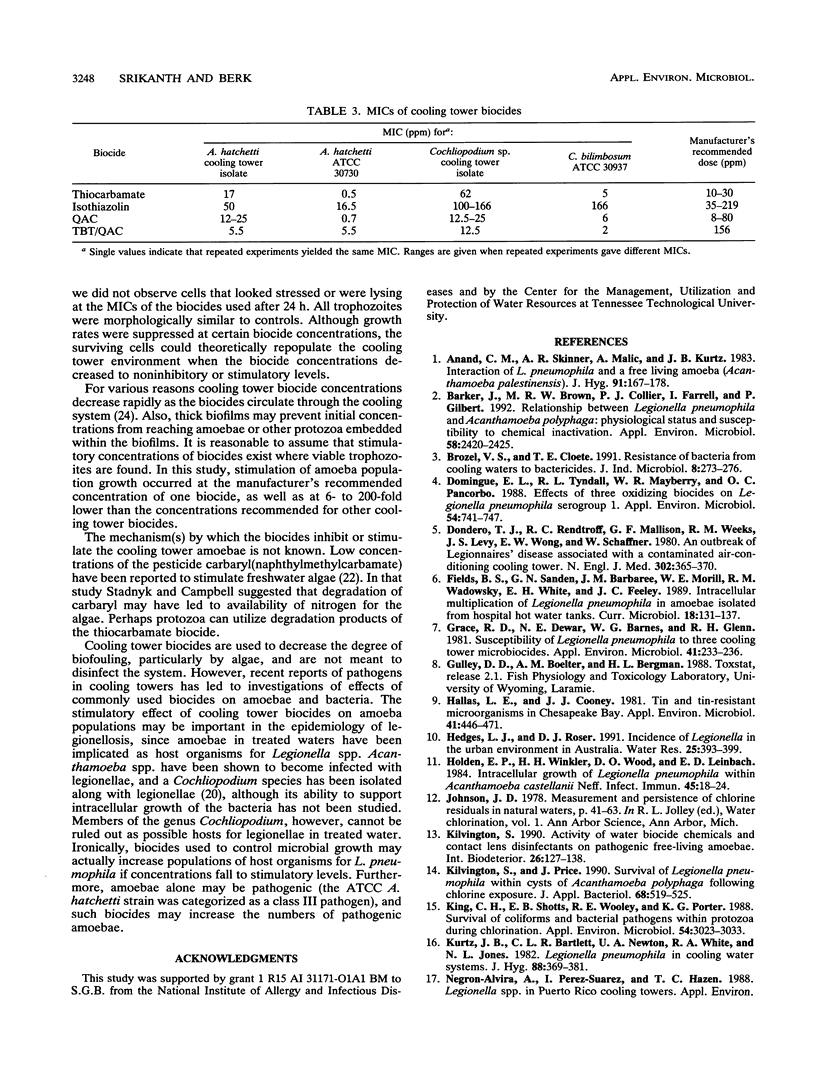Abstract
Two species of amoebae were isolated from the cooling tower of an air-conditioning system and examined for effects of exposure to four cooling tower biocides, a thiocarbamate compound, tributyltin neodecanoate mixed with quaternary ammonium compounds, another quaternary ammonium compound alone, and an isothiazolin derivative. The amoebae isolated were Acanthamoeba hatchetti and a Cochliopodium species. Two other amoeba cultures, an A. hatchetti culture and Cochliopodium bilimbosum, were obtained from the American Type Culture Collection (ATCC) and were also tested. The cooling tower isolates were more resistant to most of the biocides than the ATCC isolates were. The isothiazolin derivative was the least inhibitory to all four amoeba isolates, and tributyltin neodecanoate mixed with quaternary ammonium compounds was the most inhibitory to three of the four isolates. After exposure to lower concentrations of the biocides, including for one strain the manufacturer's recommended concentration of one biocide, the cooling tower amoeba populations increased significantly compared with unexposed controls, whereas the ATCC isolates were not stimulated at any of the concentrations tested. In some cases, concentrations which stimulated cooling tower amoebae inhibited the growth of the ATCC isolates. These results suggest that cooling tower amoebae may adapt to biocides, underscoring the need to use freshly isolated cooling tower organisms rather than organisms from culture collections for testing the efficacy of such biocides. The stimulatory effect of biocides on amoeba populations is an alarming observation, since these organisms may be reservoirs for legionellae. Biocides used to control microbial growth may actually enhance populations of host organisms for pathogenic bacteria.
Full text
PDF




Selected References
These references are in PubMed. This may not be the complete list of references from this article.
- Anand C. M., Skinner A. R., Malic A., Kurtz J. B. Interaction of L. pneumophilia and a free living amoeba (Acanthamoeba palestinensis). J Hyg (Lond) 1983 Oct;91(2):167–178. doi: 10.1017/s0022172400060174. [DOI] [PMC free article] [PubMed] [Google Scholar]
- Barker J., Brown M. R., Collier P. J., Farrell I., Gilbert P. Relationship between Legionella pneumophila and Acanthamoeba polyphaga: physiological status and susceptibility to chemical inactivation. Appl Environ Microbiol. 1992 Aug;58(8):2420–2425. doi: 10.1128/aem.58.8.2420-2425.1992. [DOI] [PMC free article] [PubMed] [Google Scholar]
- Domingue E. L., Tyndall R. L., Mayberry W. R., Pancorbo O. C. Effects of three oxidizing biocides on Legionella pneumophila serogroup 1. Appl Environ Microbiol. 1988 Mar;54(3):741–747. doi: 10.1128/aem.54.3.741-747.1988. [DOI] [PMC free article] [PubMed] [Google Scholar]
- Dondero T. J., Jr, Rendtorff R. C., Mallison G. F., Weeks R. M., Levy J. S., Wong E. W., Schaffner W. An outbreak of Legionnaires' disease associated with a contaminated air-conditioning cooling tower. N Engl J Med. 1980 Feb 14;302(7):365–370. doi: 10.1056/NEJM198002143020703. [DOI] [PubMed] [Google Scholar]
- Grace R. D., Dewar N. E., Barnes W. G., Hodges G. R. Susceptibility of Legionella pneumophila to three cooling tower microbicides. Appl Environ Microbiol. 1981 Jan;41(1):233–236. doi: 10.1128/aem.41.1.233-236.1981. [DOI] [PMC free article] [PubMed] [Google Scholar]
- Hallas L. E., Cooney J. J. Tin and tin-resistant microorganisms in chesapeake bay. Appl Environ Microbiol. 1981 Feb;41(2):466–471. doi: 10.1128/aem.41.2.466-471.1981. [DOI] [PMC free article] [PubMed] [Google Scholar]
- Holden E. P., Winkler H. H., Wood D. O., Leinbach E. D. Intracellular growth of Legionella pneumophila within Acanthamoeba castellanii Neff. Infect Immun. 1984 Jul;45(1):18–24. doi: 10.1128/iai.45.1.18-24.1984. [DOI] [PMC free article] [PubMed] [Google Scholar]
- Kilvington S., Price J. Survival of Legionella pneumophila within cysts of Acanthamoeba polyphaga following chlorine exposure. J Appl Bacteriol. 1990 May;68(5):519–525. doi: 10.1111/j.1365-2672.1990.tb02904.x. [DOI] [PubMed] [Google Scholar]
- King C. H., Shotts E. B., Jr, Wooley R. E., Porter K. G. Survival of coliforms and bacterial pathogens within protozoa during chlorination. Appl Environ Microbiol. 1988 Dec;54(12):3023–3033. doi: 10.1128/aem.54.12.3023-3033.1988. [DOI] [PMC free article] [PubMed] [Google Scholar]
- Kurtz J. B., Bartlett C. L., Newton U. A., White R. A., Jones N. L. Legionella pneumophila in cooling water systems. Report of a survey of cooling towers in London and a pilot trial of selected biocides. J Hyg (Lond) 1982 Jun;88(3):369–381. doi: 10.1017/s0022172400070248. [DOI] [PMC free article] [PubMed] [Google Scholar]
- Newsome A. L., Baker R. L., Miller R. D., Arnold R. R. Interactions between Naegleria fowleri and Legionella pneumophila. Infect Immun. 1985 Nov;50(2):449–452. doi: 10.1128/iai.50.2.449-452.1985. [DOI] [PMC free article] [PubMed] [Google Scholar]
- Paszko-Kolva C., Yamamoto H., Shahamat M., Sawyer T. K., Morris G., Colwell R. R. Isolation of amoebae and Pseudomonas and Legionella spp. from eyewash stations. Appl Environ Microbiol. 1991 Jan;57(1):163–167. doi: 10.1128/aem.57.1.163-167.1991. [DOI] [PMC free article] [PubMed] [Google Scholar]
- Rowbotham T. J. Preliminary report on the pathogenicity of Legionella pneumophila for freshwater and soil amoebae. J Clin Pathol. 1980 Dec;33(12):1179–1183. doi: 10.1136/jcp.33.12.1179. [DOI] [PMC free article] [PubMed] [Google Scholar]
- Stadnyk L., Campbell R. S., Johnson B. T. Pesticide effect on growth and 14 C assimilation in a freshwater alga. Bull Environ Contam Toxicol. 1971 Jan-Feb;6(1):1–8. doi: 10.1007/BF01559063. [DOI] [PubMed] [Google Scholar]
- Wright J. B., Ruseska I., Costerton J. W. Decreased biocide susceptibility of adherent Legionella pneumophila. J Appl Bacteriol. 1991 Dec;71(6):531–538. doi: 10.1111/j.1365-2672.1991.tb03828.x. [DOI] [PubMed] [Google Scholar]
- Yamamoto H., Sugiura M., Kusunoki S., Ezaki T., Ikedo M., Yabuuchi E. Factors stimulating propagation of legionellae in cooling tower water. Appl Environ Microbiol. 1992 Apr;58(4):1394–1397. doi: 10.1128/aem.58.4.1394-1397.1992. [DOI] [PMC free article] [PubMed] [Google Scholar]


